Yearly Archives: 2012
Some History Behind the Hobby
This is topic is one that has always interested me so I thought it would be a fun topic to post here. The below is based in a lot of different books and articles that I have read over the past few years. It’s more of a collection of some of the important milestones that played a big part in developing into the hobby we all enjoy today. I hope I have remembered all of the dates correctly, so here goes…….
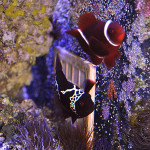
The lightning maroon clownfish finally spawned!!!
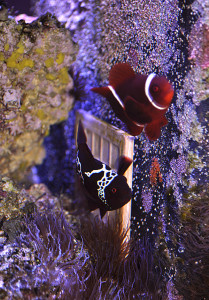
By: Matt Pedersen
Yes you read right. Matt Pedersen little “doubling down“ trick to get them to spawn that we wrote about here seems to have worked and the lightning maroon clownfish has finally spawned after 2 years of trying. This is very good news for all those who hope to keep these stunning fish one day, myself included.
Matt has been trying to get them to breed for two years now pairing it with a number of other maroon clownfish of both sexes. Finally it paired with a smaller maroon clownfish and this morning matt could finally report that they had spawned for the first time. (read the full story here.) It is a bit early to get too excited since it is common for the first spawns to fail and to produce where few fertile eggs but once a clownfish pair start to spawn they usually continue doing so. Matt should hopefully soon have a number of lightning clowns to breed from and pass on to other successfully breeders so that they can help this clown fish become more available. This clownfish really deserves to become a common sight in aquariums around the worlds and the chances of that happening greatly increased today.
Until today only two lightning maroon clownfish was ever caught, both in the waters of Papua New Guinea. Just a few weeks ago a third fish was caught in the same waters that resembles the lightning maroons but with a much less distinct pattern. See the image below. This latest catch was aquired by EcoReef UK
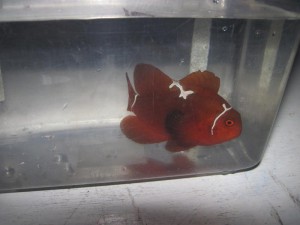
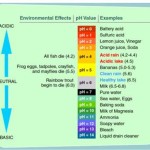
pH in Marine Aquariums
pH (Potential Hydrogen) is simply a way to measure the concentration of hydrogen ions in solution. With a PH of 7.0, water is said to be neutral, anything lower becomes acidic while anything higher is said to become alkaline (basic). The scale used to measure pH is also logarithmic due to the enormous range of hydrogen ions. Using this type of scale, you will see a increase in hydrogen ions by a factor of 10 for each 1.0 difference in the pH values. For example, when you have a PH of 6 there is 10 times as many hydrogen ions as compared to a pH of 7 and 100 times as many ions as compared to a pH of 8.0. This is a good way to illustrate the potential scope of the impact a change in pH can have.
Generally, a pH of 7.9 to 8.4 is considered to be the normal range for a average marine aquarium. I always like to keep my pH stable at a value between 8.0 and 8.3. pH is a very important element of water chemistry to understand and test for, as large and quick swings in your pH can cause stress to fish and corals even resulting in deaths in certain situations. pH is one of the aspects of water quality that can also be an indicator or symptom that something else may be off in your set-up. For that reason I do not recommended trying to adjust your pH with pH stabilizing or adjusting chemicals as you may not be fixing the potential problem(s) but only masking the symptoms. If you are having difficulty maintaining your pH, you should first try to understand the cause of the pH problems and address those causes first. That approach has always worked best for me.
The two biggest factors that commonly affect your pH are:
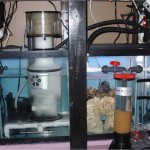
Some Sump Basics
Simply worded, a sump is just a secondary tank that is set-up and linked into a main / display tank as an option for placing equipment as well as providing filtration for the main tank.
If I have learned anything in this hobby it is that there are many many different ways to achieve a healthy and thriving tank. This could not be any truer with how you choose to set up a sump. Likely the best way to approach this topic is to describe the factors that I learned which go into designing your sump and then show you how I set up my sump just as one example. I hope you will find these sump basics helpful.
Lightning Maroon Clownfish
The lightning Maroon Clownfish is a one of a kind truly stunning clown fish that was caught of Papua New Guinea. One of a kind fish like this usually go to people willing to pay biiiig money for them but in this case Blue Zoo Aquatics opted to make sure that it went to an established breeder instead to make sure that we all might get to enjoy these stunning color morph in the future. It would not be the first time a new color morph has been developed form a single original fish.
Although the lightning Maroon Clownfish paired of last year (2011) the pair has so far not laid any eggs or produced any offspring.
Pairing video:
The breeder has now decided to try to use a technique called “Double down” in which you move a batch of eggs another couple laid to the couple you want to start breeding. The idea is that either the fish start caring for the eggs that are given to them, which usually triggers them to start laying their own egg before long, or they eat the eggs that are given to them and get a very nutritious meal. In this case, the eggs, taken from an Onyx Percula spawning, were received somewhat well and the pair is showing signs of caring for the eggs which might be a good sign and hopefully we will get to see baby lightning Maroon Clownfish before long. If you want more info or keep up to date with the attempts to spawn the lightning Maroon Clown fish you can visit the lightning project website and if you want more info on this particular breeding attempt you can click here.
The lightning Maroon Clownfish guarding the new eggs:
Coral Diseases
Background
This is a very difficult topic to learn about, as for the most part, not enough scientific study has been completed yet. Coral disease research really did not get a lot of focus until the mid 1970s with many of the common diseases only becoming properly identified in the early 1990s. With the increasing levels of pollutants in the waters of the coral reefs, combined with the effects of global warming, more and more diseases have be developing, along with the frequency they are being found in among the ocean’s coral reefs.
This is (IMO) a very serious threat to the long-term health of our coral reefs today. For example, White band disease has had a devastating impact in the coral reefs in the Florida Keys (killing ~95% of all Acropora SPS corals), and in the Caribbean (infecting ~50% of the shallow water, mostly Elkhorn SPS corals within the first five years after this disease was discovered there). During the past 10 years, the Caribbean coral reefs are being affected more and more each year. New diseases have even started to surface that affect coralline algae (Coralline Lethal Algae Disease) which could also have a significant impact on health of our coral reefs.
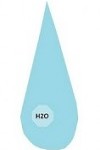
Mixing Saltwater
Mixing saltwater
Perhaps the most vital part of the marine aquarium is properly mixing salt water.
The reefs of the world are the most stable environments on Earth, despite human activity and pollution tipping that balance in the reefs of the Caribbean Sea and the east coast of Florida. The natural reef water possesses a set ratio of salts, minerals and trace elements. Temperatures vary little, and in most reefs, not at all.
Several different manufacturers product synthetic salts that posses the proper ratio of minerals and trace elements, but there are some brands that are superior to others in that respect. Seek out impartial reviews to give you an idea which salt mix to buy.
Natural Sea Water (NSW) contains 11 major elements and a handful of trace elements. To simulate that in our marine tanks one must make every effort to be as close to the natural world as possible.
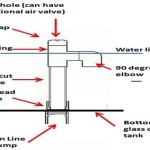
Aquarium Plumbing Basics
When you set out to plumb an aquarium set-up with a sump, the more planning / thought you put into the original set-up, the better it will be in the long run. This is not a very hard thing to do at all, if you focus on the basics and understand them. I tend to think of it in flowing different steps: A) Planning of your flow rates, B) planning the material types and sizes, and C) installation / set-up of the plumbing system. All of what you are about to read below is based on my experiences with various data from some North American manufactures of plumbing products (IPEX, Canplas, and Boshart) which is also detailed in the American Society for Testing and Materials (ASTM) standards.
I will explain what I mean by each step then I will show you examples from one of my reef tanks
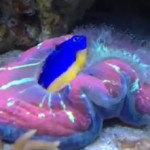
Open brain corals capable of catching and consuming live healthy fish
You seldom think about corals catching and eating your otherwise healthy fish but it might be good to know that it does happen. You might want to avoid coral species such as Trachyphyllia and other large polyp stone corals in tanks where you keep fish you really care about. The risk of something like this happening is small but ever present.
The video below shows an open brain coral in the tank of Dmitry Tumanovthat has caught and is consuming an otherwise healthy, living, large azure damsel fish. Dimitry shot this video after having lost several fish that was no where to be found.
Via reefbuilders

Calcium Reactors
Calcium reactors
Calcium reactors (or as I like to call them mineral reactors) are one of the best ways to maintain natural sea water levels in a marine aquarium. Once adjusted, they are also the easiest way to maintain NSW (Natural Sea Water) levels. Not only do they maintain Calcium and alkalinity levels, but also Magnesium and several trace elements This article will describe each component of a Calcium reactor as well as setting up and adjusting one. With a properly adjusted Calcium reactor and good media, daily dosing becomes a thing of the past, which give you more time to enjoy your reef.